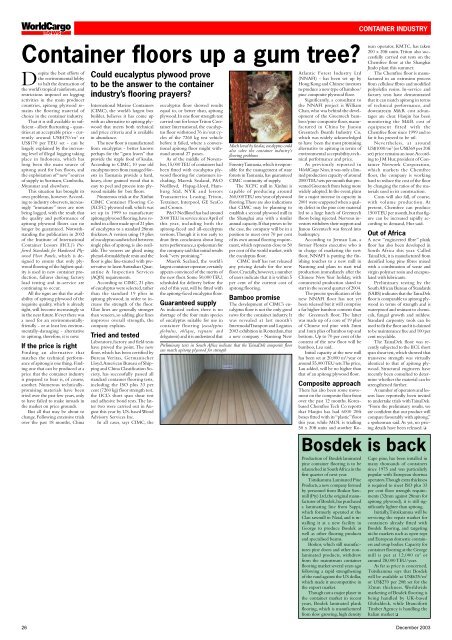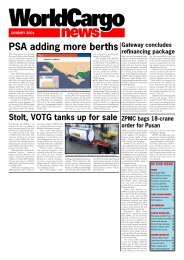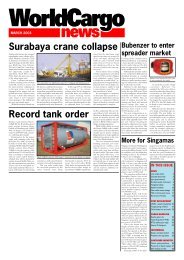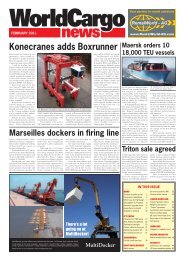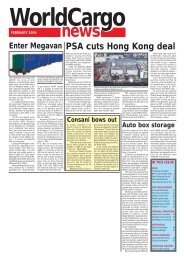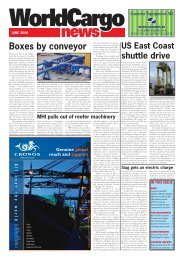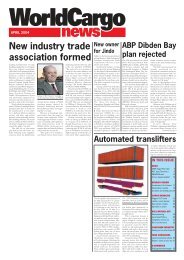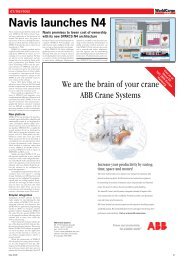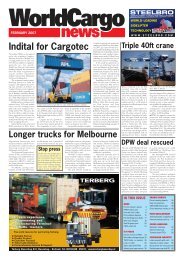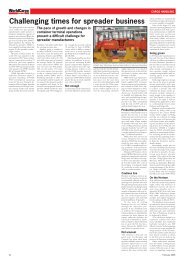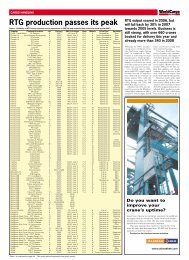WCN Dec Front page - WorldCargo News Online
WCN Dec Front page - WorldCargo News Online
WCN Dec Front page - WorldCargo News Online
You also want an ePaper? Increase the reach of your titles
YUMPU automatically turns print PDFs into web optimized ePapers that Google loves.
<strong>WorldCargo</strong>newsCONTAINER INDUSTRYContainer floors up a gum tree?Despite the best efforts ofthe environmental lobbyto halt the destruction ofthe world’s tropical rainforests, andrestrictions imposed on loggingactivities in the main producercountries, apitong plywood remainsthe flooring material ofchoice in the container industry.That it is still available in sufficient- albeit fluctuating - quantitiesat an acceptable price - currentlyaround US$470/m 3 orUS$170 per TEU set - can belargely explained by the increasinglevel of illegal logging takingplace in Indonesia, which haslong been the main source ofapitong used for box floors, andthe exploitation of “new” sourcesof supply in Surinam, Cambodia,Myanmar and elsewhere.This situation has brought itsown problems, however. Accordingto industry observers, increasingly“immature” trees are nowbeing logged, with the result thatthe quality and performance ofapitong plywood floors can nolonger be guaranteed. Notwithstandingthe publication in 2002of the Institute of InternationalContainer Lessors (IICL)’s PreferredStandards for Hardwood PlywoodFloor Panels, which is designedto ensure that only plywoodflooring of the highest qualityis used in new container production,failures during factoryload testing and in-service arecontinuing to occur.All the signs are that the availabilityof apitong plywood of therequisite quality, which is alreadytight, will become increasingly soin the near future. If ever there wasa need for an environmentallyfriendly- or at least less environmentally-damaging- alternativeto apitong, therefore, it is now.If the price is rightFinding an alternative thatmatches the technical performanceof apitong is one thing. Findingone that can be produced at aprice that the container industryis prepared to bear is, of course,another. Numerous technicallypromisingmaterials have beentried over the past few years, onlyto have failed to make inroads inthe market on price grounds.But all that may be about tochange. Following extensive trialsover the past 18 months, ChinaCould eucalyptus plywood proveto be the answer to the containerindustry’s flooring prayers?International Marine Containers(CIMC), the world’s largest boxbuilder, believes it has come upwith an alternative to apitong plywoodthat meets both technicaland price criteria and is availablein abundance.The new floor is manufacturedfrom eucalyptus - better knownperhaps for the “gum leaves” thatprovide the staple food of koalas.According to CIMC, 10 year oldeucalyptus trees from managed forestsin Tasmania provide a hard,heavy, close grained wood that iseasy to peel and process into plywoodsuitable for box floors.Numerous trials at the XinhuiCIMC Container Flooring Co(XCFC) plywood mill, which wasset up in 1999 to manufactureapitong plywood flooring, have resultedin a floor made up of 21 pliesof eucalyptus to a standard 28mmthickness. A version using 19 pliesof eucalyptus sandwiched betweensingle plies of apitong, is also available.The veneers are glued usingphenol-formaldehyde resin and thefloor is glue line-treated with preservativeto latest Australian Quarantine& Inspection Services(AQIS) requirements.According to CIMC, 21 pliesof eucalyptus were selected, ratherthan the standard 19 plies inapitong plywood, in order to increasethe strength of the floor.Glue lines are generally strongerthan veneers, so adding glue linesimproves overall strength, thecompany explains.Tried and testedLaboratory, factory and field testshave proved the point. The newfloor, which has been certified byBureau Veritas, GermanischerLloyd, American Bureau of Shippingand China Classification Society,has successfully passed allstandard container flooring tests,including the ISO plus 33 percent (7260 kg) floor strength test,the IICL’s short span shear testand adhesive bond tests. The lattertwo were carried out in Augustthis year by US-based WoodAdvisory Services Inc.In all cases, says CIMC, theeucalyptus floor showed resultsequal to, or better than, apitongplywood. In one floor strength testcarried out for lessor Triton ContainerInternational, the eucalyptusfloor withstood 76 in/out cyclesof the 7260 kg test vehiclebefore it failed, where a conventionalapitong floor might withstandaround 27 passes.As of the middle of November,15,000 TEU of containers hadbeen fitted with eucalyptus plywoodflooring for customers including,Maersk Sealand, P&ONedlloyd, Hapag-Lloyd, HamburgSüd, NYK and lessorsTransamerica Leasing, Triton,Textainer, Interpool, GE SeaCoand Cronos.P&O Nedlloyd has had around2000 TEU in service since April ofthis year, including both theapitong-faced and all-eucalyptusversions. Though it is too early todraw firm conclusions about longterm performance, a spokesman forthe company said that initial resultslook “very promising.”Maersk Sealand, the world’slargest container operator, certainlyappears convinced of the merits ofthe new floor. Some 50,000 TEU,scheduled for delivery before theend of this year, will be fitted withthe apitong-faced eucalyptus floor.Guaranteed supplyAs indicated earlier, there is noshortage of the four main speciesof eucalyptus suitable for use incontainer flooring (eucalyptusglobulus, oblique, regnans anddelegatensis) and it is understood thatMuch loved by koalas, eucalyptus couldalso solve the container industry’sflooring problemsForestry Tasmania, which is responsiblefor the management of stateforests in Tasmania, has guaranteedCIMC continuity of supply.The XCFC mill in Xinhui iscapable of producing around360,000 TEU sets/year of plywoodflooring. There are also indicationsthat CIMC may be planning toestablish a second plywood mill inthe Shanghai area with a similarannual capacity. If that proves to bethe case, the company will be in aposition to meet over 70 per centof its own annual flooring requirement,which represents close to 50per cent of the world market, withthe eucalyptus floor.CIMC itself has not releasedany pricing details for the newfloor. Crucially, however, a numberof users indicate that it is within 5per cent of the current cost ofapitong flooring.Bamboo promiseThe development of CIMC’s eucalyptusfloor is not the only goodnews for the container industry. Itwas revealed at last month’sIntermodal Transport and Logistics2003 exhibition in Rotterdam, thata new company - Nantong NewPreliminary tests in South Africa indicate that the TainaDek composite floorcan match apitong plywood for strengthAtlantic Forest Industry Ltd(NNAFI) - has been set up byHong Kong and Chinese investorsto produce a new type of bamboo/pine composite plywood floor.Significantly, a consultant tothe NNAFI project is WilliamChan, who was behind the developmentof the Greentech bamboo/pinecomposite floor, manufacturedin China by JianouGreentech Boards Industry Co,which was widely acknowledgedto have been the most promisingalternative to apitong in terms ofenvironmental acceptability, technicalperformance and price.As previously reported in<strong>WorldCargo</strong> <strong>News</strong>, it was only a limitedproduction capacity of around2000 TEU sets per month that preventedGreentech from being morewidely adopted. In the event, plansfor a major increase in capacity in2001 were scuppered when a qualitydefect in the pine core materialled to a large batch of Greentechfloors being rejected. Nervous investorswithdrew their support andJianou Greentech was forced intobankruptcy.According to Jerman Lau, aformer Florens executive who isin charge of marketing the newfloor, NNAFI is putting the finishingtouches to a new mill inNantong and plans to start trialproduction immediately after theChinese New Year holiday, withcommercial production slated tostart in the second quarter of 2004.The precise specification of thenew NNAFI floor has not yetbeen released but it will comprisea far higher bamboo content thanthe Greentech floor. The latterwas made up of a core of 19 pliesof Chinese red pine with 2mmand 1mm plies of bamboo top andbottom. Up to 70 per cent of thecontent of the new floor will bebamboo, Lau said.Initial capacity at the new millhas been set at 20,000 m 3 /year oraround 55,000 TEU sets. The price,Lau added, will be no higher thanthat of an apitong plywood floor.Composite approachThere has also been some movementon the composite floor frontover the past 12 months. KoreabasedChemfree Tech Co reportsthat Hanjin has had 6000 20ftboxes fitted with its “plastic” floorthis year, while MOL is trialling50 x 20ft units and another Koreanoperator, KMTC, has taken200 x 20ft units. Triton also successfullycarried out tests on theChemfree floor at the ShanghaiJindo plant this summer.The Chemfree floor is manufacturedin an extrusion processfrom cellulose fibres and modifiedpolyolefin resins. In-service andfactory tests have demonstratedthat it can match apitong in termsof technical performance, anddownstream M&R cost advantagesare clear. Hanjin has beenmonitoring the M&R cost ofequipment fitted with theChemfree floor since 1999 and sofar it has proved to be nil.Nevertheless, at aroundUS$1000/m 3 (or US$369 per 20ftset) price remains an issue. Accordingto J M Hur, president of ContainerNetwork Corporation,which markets the Chemfreefloor, the company is workinghard to reduce the cost of the floorby changing the ratios of the materialsused in its construction.Costs will also fall, of course,with volume production. Atpresent, Chemfree can produce1500 TEU per month, but that figurecan be increased rapidly accordingto demand, Hur said.Out of AfricaA new “engineered fibre” plankfloor has also been developed inSouth Africa this year. CalledTainaDek, it is manufactured fromdensified long pine fibres mixedwith a combination of waste andvirgin polymer resin and encapsulatedwith lubricants.Preliminary testing by theSouth African Bureau of Standards(SABS) indicates that the TainaDekfloor is comparable to apitong plywoodin terms of strength and iswaterproof and resistant to chemicals,fungal growth and mildew.Standard carpentry tools can beused to fit the floor and it is claimedto be maintenance free and 100 percent recyclable.The TainaDek floor was recentlysubjected to the IICL shortspan shear test, which showed thattransverse strength was virtuallyidentical to that of apitong plywood.Structural engineers haverecently been consulted to determinewhether the material can bestrengthened further.A number of operators and lessorshave reportedly been invitedto undertake trials with TainaDek.“From the preliminary results, weare confident that our product willcompare favourably with apitong,”a spokesman said. As yet, no pricingdetails have been released. ❏Bosdek is backProduction of Bosdek laminatedpine container flooring is to berelaunched in South Africa in thefirst quarter of next year.Tsitsikamma Laminated PineProducts, a new company formedby personnel from Boskor Sawmill(Pty) Ltd, the original manufacturerof Bosdek, has purchaseda laminating line from Sappi,which formerly operated at theClan sawmill in Natal, and is installingit at a new facility inGeorge to produce Bosdek aswell as other flooring productsand specialised beams.Boskor, which still manufacturespine doors and other nonlaminatedproducts, withdrewfrom the mainstream containerflooring market several years agofollowing a rapid strengtheningof the rand against the US dollar,which made it uncompetitive inthe export market.Though not a major player inthe container market in recentyears, Bosdek laminated plankflooring, which is manufacturedfrom slow growing, high densityCape pine, has been installed inmany thousands of containerssince 1975 and was particularlypopular with European shortseaoperators. Though extra thicknessis required to meet ISO plus 33per cent floor strength requirements(32mm against 28mm forapitong plywood), it is still significantlylighter than apitong.Initially, Tsitsikamma will beservicing the repair market forcontainers already fitted withBosdek flooring, and targetingniche markets such as open topsand European domestic containersand swap bodies. Capacity forcontainer flooring at the Georgemill is put at 12,000 m 3 oraround 28,000 TEU/year.As far as price is concerned,Tsitsikamma says that Bosdekwill be available at US$625/m 3or US$270 per 20ft set for the32mm thickness. Worldwidemarketing of Bosdek flooring isbeing handled by UK-basedGlobaldeck, while BrancifortiTimber Agency is handling theItalian market ❏26<strong>Dec</strong>ember 2003


